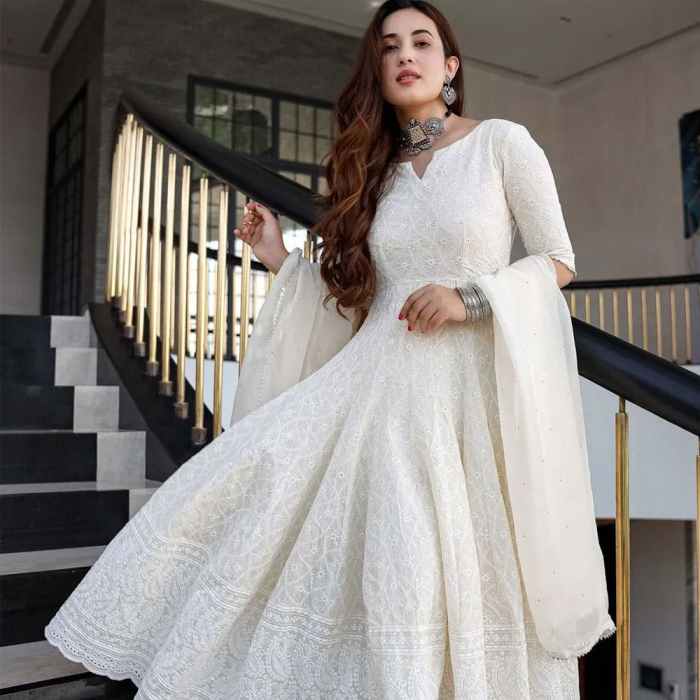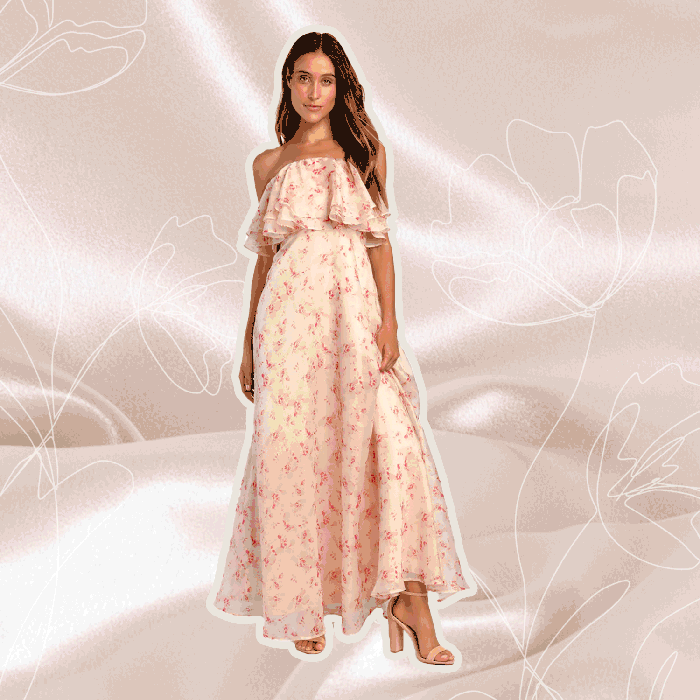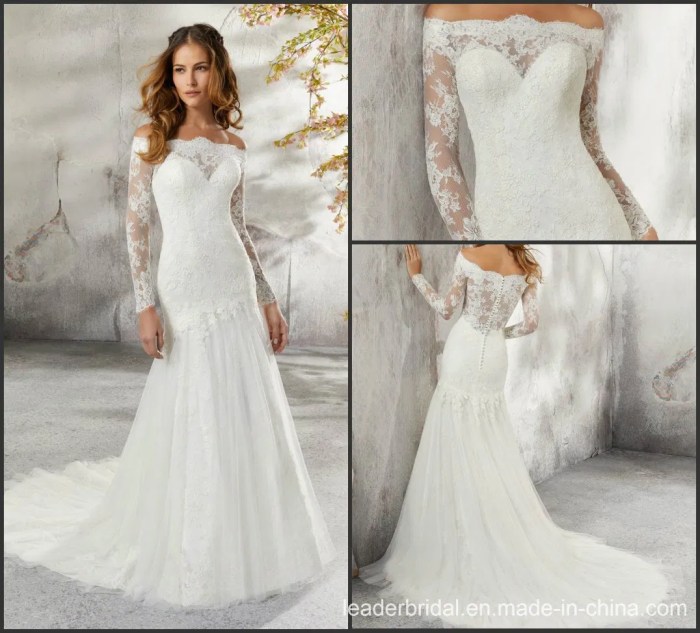Regional Variations in Traditional Indian Wedding Dresses: Indian Wedding Dress Traditional
Indian wedding dress traditional – India’s vast cultural landscape is reflected in the diverse array of traditional wedding attire worn across its many regions. From the vibrant silks of the South to the opulent embroidery of the North, each region boasts unique styles, fabrics, and embellishments that tell a story of heritage and tradition.
Regional Variations in Bridal Attire
The following table highlights key distinctions in traditional wedding attire from five major regions of India.
| Dress Name | Region | Fabrics Used | Embellishments |
|---|---|---|---|
| Kanjeevaram Silk Saree | South India (Tamil Nadu) | Pure silk, often with zari (gold or silver thread) weaving | Intricate zari work, temple borders, rich colors |
| Banarasi Silk Saree | North India (Uttar Pradesh) | Fine silk, often with gold or silver zari | Brocade weaving, intricate motifs, rich gold detailing |
| Paithani Saree | West India (Maharashtra) | Silk, often with gold or silver zari | Characteristic diagonal stripes, intricate zari work, peacock motifs |
| Baluchari Saree | East India (West Bengal) | Silk, often with intricate designs woven into the fabric | Mythological scenes or depictions of nature woven into the saree |
| Mishing Mekhela Chador | Northeast India (Assam) | Eri silk or Muga silk | Geometric patterns, traditional motifs, often handwoven |
Silhouette and Style Comparisons of Bridal Sarees
Bridal sarees across different regions exhibit variations in silhouette and style. For instance, South Indian Kanjeevaram sarees are known for their heavier, more structured pallus (the draped end of the saree), creating a regal and opulent look. In contrast, the lighter, more flowing Banarasi sarees from North India often feature intricate embroidery and delicate embellishments, offering a more graceful and elegant silhouette.
Paithani sarees from West India strike a balance, with their rich fabrics and bold designs creating a visually striking yet manageable drape.
Cultural Significance of Colors in Wedding Attire, Indian wedding dress traditional
Color holds immense cultural significance in Indian weddings. In South India, the vibrant red color symbolizes auspiciousness, fertility, and prosperity, often seen in Kanjeevaram sarees. The deep maroon and gold combinations are also prevalent, reflecting traditional wealth and status. In North India, red remains dominant, but shades of orange, yellow, and even pastel colors are increasingly seen, representing joy, optimism, and the vibrancy of new beginnings.
These variations reflect the diversity of traditions within India.
Fabric and Embroidery Techniques in Traditional Indian Wedding Dresses
The artistry of Indian wedding dresses lies not only in their design but also in the intricate techniques used in creating the fabrics and embellishments. These techniques are often passed down through generations, representing a rich tapestry of cultural heritage.
Traditional Weaving Techniques
Traditional weaving techniques, such as the intricate jamdani weaving (creating patterns by manipulating the weft threads) used in some Banarasi sarees, or the complex ikat dyeing (resist dyeing technique) that creates the unique patterns in Patola sarees, have been practiced for centuries. These techniques showcase the mastery of Indian artisans and their deep understanding of textile arts. The historical context of these techniques often links them to specific royal courts or artisan communities, lending further significance to the garments.
Types of Embroidery
Various embroidery techniques add layers of artistry and meaning to Indian wedding dresses. Five common examples are:
- Zardozi: Uses gold and silver threads to create intricate patterns, often incorporating precious stones and pearls.
- Aari: A type of surface embroidery using a hooked needle, creating dense and detailed designs.
- Chikankari: A delicate white embroidery on muslin fabric, known for its intricate patterns and fine detail.
- Kantha: A running stitch embroidery technique, often using old fabrics and creating layered textures.
- Phulkari: A type of embroidery done on coarse cotton fabric using vibrant colors and densely packed stitches.
Hypothetical Wedding Dress Design
A hypothetical wedding dress could incorporate Zardozi embroidery on the bodice for a regal touch, Aari embroidery along the border of the saree for a delicate flow, and Kantha embroidery on the pallu to add a layer of texture and traditional charm. The placement of each technique would create a visually captivating interplay of textures and details, showcasing the rich diversity of Indian embroidery styles.
Jewelry and Accessories in Traditional Indian Wedding Attire
Jewelry plays a pivotal role in completing the bridal look, adding not only aesthetic appeal but also symbolic meaning. Each piece tells a story, reflecting the bride’s heritage and wishes for a blessed future.
Key Pieces of Traditional Bridal Jewelry
| Jewelry Item | Region | Material | Symbolic Meaning |
|---|---|---|---|
| Mangalsutra | Pan-India | Gold, often with black beads | Symbol of marriage and marital bond |
| Jhumkas | Pan-India | Gold, silver, or precious stones | Symbol of fertility and prosperity |
| Nath (Nose Ring) | North & West India | Gold, silver, or precious stones | Symbol of marital status and beauty |
| Bangles (Chura) | North India | Lac, glass, or metal | Symbol of good fortune and protection |
| Kasu Mala (Coin Necklace) | South India | Gold coins | Symbol of prosperity and abundance |
Evolution of Bridal Jewelry Styles
Over the past century, traditional bridal jewelry has undergone a subtle evolution. While classic designs remain popular, contemporary interpretations incorporate new materials, motifs, and settings. The use of diamonds and other precious stones has increased, reflecting changing economic conditions and fashion trends. However, the symbolic meaning of many traditional pieces continues to hold cultural significance.
Bridal Headpiece Description
A traditional bridal headpiece, often called a maang tikka, is typically a forehead ornament made of gold, adorned with precious stones and intricate detailing. It connects to a delicate chain that extends to the hair, adding elegance and grace. The design elements often reflect regional variations, with some featuring floral motifs, others geometric patterns, or even religious symbols.
The maang tikka’s cultural significance lies in its representation of the bride’s purity, beauty, and auspiciousness, symbolizing the union of two families.
Traditional Indian wedding dresses showcase a rich tapestry of regional styles and embellishments. The vibrant colors and intricate embroidery often reflect family heritage. For a broader perspective on South Asian bridal wear, exploring the stunning designs showcased on sites like indian pakistani wedding dresses is highly recommended. Returning to the focus on Indian traditions, the choice of fabric, from silk to brocade, further contributes to the unique beauty of the attire.
The Significance of Color and Symbolism in Traditional Indian Wedding Dresses
Color and symbolism are deeply interwoven into the fabric of Indian wedding attire, each element carrying layers of meaning and cultural significance.
Cultural Significance of Colors
Red, often considered the most auspicious color, symbolizes passion, fertility, and good fortune. Gold represents prosperity, wealth, and divinity. Other colors, such as orange, yellow, and green, are also incorporated, each carrying its own symbolic meaning depending on the region and tradition. The combination of colors often reflects the specific cultural nuances of the bride’s family and heritage.
Symbolic Meaning of Motifs and Patterns
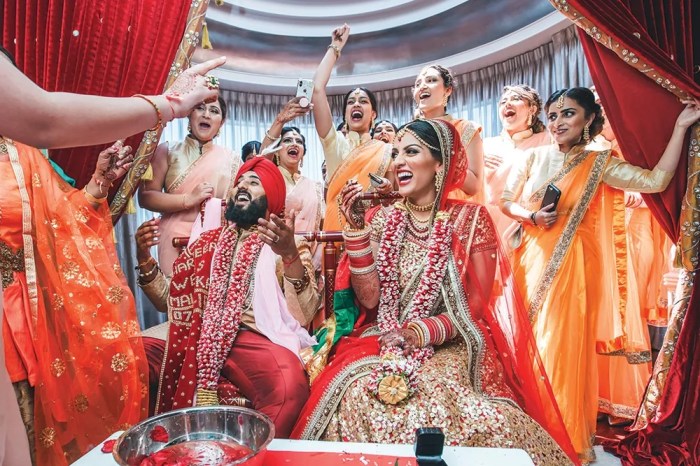
Source: manhattanbride.com
Motifs and patterns on wedding dresses often depict religious symbols, auspicious animals (like peacocks or elephants), or floral designs representing nature’s abundance. These intricate details add depth and richness to the attire, conveying blessings and wishes for a prosperous future. The specific motifs and their placement can also vary across regions, reflecting local traditions and beliefs.
Aesthetic and Cultural Impact of Color and Symbolism
The careful selection of colors and the incorporation of symbolic motifs contribute significantly to the overall aesthetic and cultural impact of Indian wedding attire. The vibrant hues and intricate details create a visually stunning ensemble, while the symbolic meanings imbue the garments with a deeper cultural significance, connecting the bride to her heritage and traditions. The attire serves as a powerful visual representation of cultural identity and celebratory traditions.
Modern Interpretations of Traditional Indian Wedding Dresses
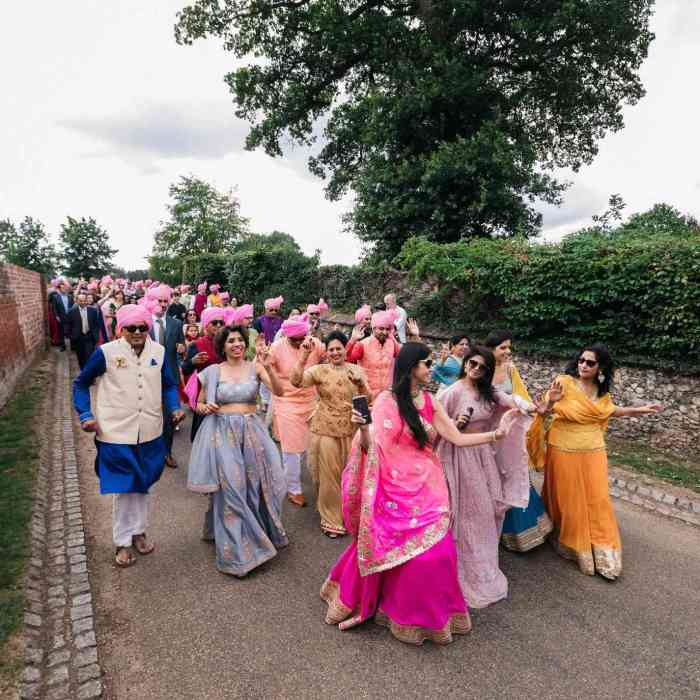
Source: brides.com
While tradition remains deeply valued, contemporary designers are constantly reimagining traditional Indian wedding dresses, blending classic elements with modern aesthetics.
Traditional vs. Contemporary Styles
Key differences between traditional and contemporary Indian wedding dresses include:
- Silhouettes: Traditional styles often feature more structured and flowing silhouettes, while contemporary designs incorporate more fitted or asymmetrical cuts.
- Fabrics: While silk remains a staple, contemporary dresses may incorporate other luxurious fabrics like velvet, crepe, or net.
- Embellishments: Traditional embroidery techniques are often combined with modern embellishments like sequins, beads, and 3D floral appliqués.
- Color Palettes: While red remains popular, contemporary palettes are more diverse, incorporating pastel shades, metallics, and unconventional color combinations.
Examples of Modern Interpretations
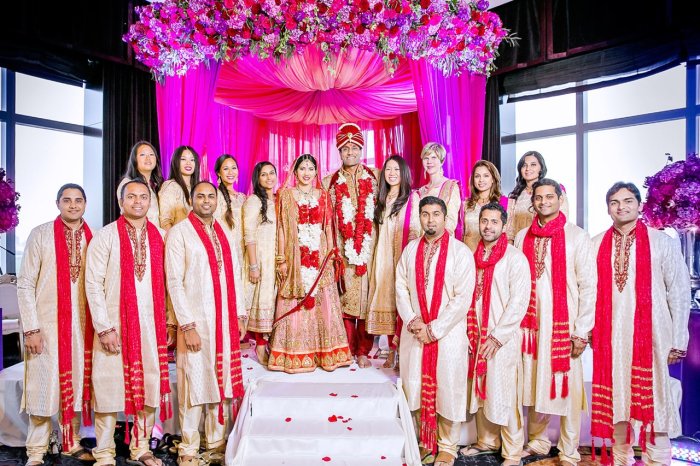
Source: insideweddings.com
| Designer | Dress Style | Traditional Elements | Modern Adaptations |
|---|---|---|---|
| (Example Designer 1) | A-line lehenga | Intricate Zardozi embroidery | Modern cut, use of unconventional colors |
| (Example Designer 2) | Saree gown | Kanjeevaram silk | Contemporary silhouette, asymmetrical drape |
| (Example Designer 3) | Pant suit | Bandhani print | Modern tailoring, use of lighter fabrics |
Impact of Globalization and Changing Fashion Trends
Globalization and evolving fashion trends have influenced the evolution of traditional Indian wedding attire. Exposure to international styles has led to a fusion of traditional and contemporary elements, resulting in innovative designs that respect heritage while embracing modern aesthetics. The use of new fabrics, embellishments, and silhouettes reflects this dynamic interplay between tradition and contemporary design sensibilities.
FAQ
What is the significance of a specific color like red in an Indian wedding?
Red symbolizes prosperity, fertility, and good fortune, making it a highly auspicious color for weddings.
How long does it typically take to create a traditional Indian wedding dress?
The time varies greatly depending on the intricacy of the embroidery and embellishments, ranging from several weeks to several months.
Are there any specific rituals associated with wearing the wedding dress?
Yes, many rituals involve the bride’s attire, often including blessings from elders and specific timings for changing into the wedding outfit.
What are some modern alternatives to traditional bridal sarees?
Modern brides often opt for lehengas, gowns, or Indo-western fusion styles while incorporating traditional elements like embroidery or colors.

